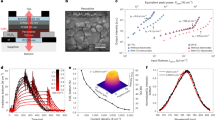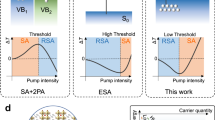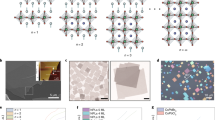Abstract
Organic–inorganic lead halide quasi-two-dimensional (2D) perovskites are promising gain media for lasing applications because of their low cost, tunable colour, excellent stability and solution processability1,2,3. Optically pumped continuous-wave (CW) lasing is highly desired for practical applications in high-density integrated optoelectronics devices and constitutes a key step towards electrically pumped lasers4,5,6. However, CW lasing has not yet been realized at room temperature because of the ‘lasing death’ phenomenon (the abrupt termination of lasing under CW optical pumping), the cause of which remains unknown. Here we study lead halide-based quasi-2D perovskite films with different organic cations and observe that long-lived triplet excitons considerably impede population inversion during amplified spontaneous emission and optically pumped pulsed and CW lasing. Our results indicate that singlet–triplet exciton annihilation is a possible intrinsic mechanism causing lasing death. By using a distributed-feedback cavity with a high quality factor and applying triplet management strategies, we achieve stable green quasi-2D perovskite lasers under CW optical pumping in air at room temperature. We expect that our findings will pave the way to the realization of future current-injection perovskite lasers.
This is a preview of subscription content, access via your institution
Access options
Access Nature and 54 other Nature Portfolio journals
Get Nature+, our best-value online-access subscription
$29.99 / 30 days
cancel any time
Subscribe to this journal
Receive 51 print issues and online access
$199.00 per year
only $3.90 per issue
Buy this article
- Purchase on Springer Link
- Instant access to full article PDF
Prices may be subject to local taxes which are calculated during checkout



Similar content being viewed by others
Data availability
The data that support the findings of this study are available from the corresponding authors upon reasonable request.
References
Sutherland, B. R. & Sargent, E. H. Perovskite photonic sources. Nat. Photon. 10, 295–302 (2016).
Zhang, H. et al. 2D Ruddlesden–Popper perovskites microring laser array. Adv. Mater. 30, 1706186 (2018).
Raghavan, C. et al. Low-threshold lasing from 2D homologous organic−inorganic hybrid Ruddlesden−Popper perovskite single crystals. Nano Lett. 18, 3221–3228 (2018).
Samuel, I. D. W. & Turnbull, G. A. Organic semiconductor lasers. Chem. Rev. 107, 1272–1295 (2007).
Kuehne, A. J. C. & Gather, M. C. Organic lasers: recent developments on materials, device geometries, and fabrication techniques. Chem. Rev. 116, 12823–12864 (2016).
Fan, F. et al. Continuous-wave lasing in colloidal quantum dot solids enabled by facet-selective epitaxy. Nature 544, 75–79 (2017).
Wang, K. et al. Recent advances in perovskite micro- and nanolasers. Adv. Opt. Mater. 6, 1800278 (2018).
Xing, G. et al. Low-temperature solution-processed wavelength-tunable perovskites for lasing. Nat. Mater. 13, 476–480 (2014).
Brenner, P. et al. Continuous wave amplified spontaneous emission in phase-stable lead halide perovskites. Nat. Commun. 10, 988 (2019).
Harwell, J. R. et al. Green perovskite distributed feedback lasers. Sci. Rep. 7, 11727 (2017).
Jia, Y. et al. Continuous-wave lasing in an organic–inorganic lead halide perovskite semiconductor. Nat. Photon. 11, 784–788 (2017).
Li, Z. et al. Room-temperature continuous-wave operation of organometal halide perovskite lasers. ACS Nano 12, 10968–10976 (2018).
Manser, J., Christins, J. & Kamat, P. Intriguing optoelectronic properties of metal halide perovskites. Chem. Rev. 116, 12956–13008 (2016).
Veldhuis, S. A. et al. Perovskite materials for light-emitting diodes and lasers. Adv. Mater. 28, 6804–6834 (2016).
Quan, L. N., García de Arquer, F. P., Sabatini, R. P. & Sargent, E. H. Perovskites for light emission. Adv. Mater. 30, 1801996 (2018).
Yuan, M. et al. Perovskite energy funnels for efficient light-emitting diodes. Nat. Nanotechnol. 11, 872–877 (2016).
Baldo, M. A., Holmes, R. J. & Forrest, S. R. Prospects for electrically pumped organic lasers. Phys. Rev. B 66, 035321 (2002).
Lehnhardt, M., Riedl, T., Weimann, T. & Kowalsky, W. Impact of triplet absorption and triplet-singlet annihilation on the dynamics of optically pumped organic solid-state lasers. Phys. Rev. B 81, 165206 (2010).
Sandanayaka, A. S. D. et al. Indication of current-injection lasing from an organic semiconductor. Appl. Phys. Express 12, 061010 (2019).
Qin, C. et al. Triplet management for efficient perovskite light-emitting diodes. Nat. Photon. 14, 70–75 (2020).
Becker, M. A. et al. Bright triplet excitons in caesium lead halide perovskites. Nature 553, 189–193 (2018).
Fujiwara, K. et al. Excitation dynamics in layered lead halide perovskite crystal slabs and microcavities. ACS Photonics 7, 845–852 (2020).
Qin, L. et al. Temperature dependent amplified spontaneous emission of vacuum annealed perovskite films. RSC Advances 7, 15911–15916 (2017).
Pourdavoud, N. et al. Room-temperature stimulated emission and lasing in recrystallized cesium lead bromide perovskite thin films. Adv. Mater. 31, 1903717 (2019).
Andrew, P., Turnbull, G. A., Samuel, I. D. W. & Barnes, W. L. Photonic band structure and emission characteristics of a metal-backed polymeric distributed feedback laser. Appl. Phys. Lett. 81, 954–956 (2002).
Samuel, I. D. W., Namdas, E. B. & Turnbull, G. A. How to recognize lasing. Nat. Photon. 3, 546–549 (2009).
Qin, C., Matsushima, T., Fujihara, T., Potscavage, W. J., Jr & Adachi, C. Degradation mechanisms of solution-processed planar perovskite solar cells: thermally stimulated current measurement for analysis of carrier traps. Adv. Mater. 28, 466–471 (2016).
Acknowledgements
We thank M. R. Leyden, T. Cheng and S. Terakawa for their support and discussion. We thank W. J. Potscavage Jr at Kyushu University for assistance with the preparation of this manuscript. This work was supported by the Japan Science and Technology Agency (JST), ERATO, Adachi Molecular Exciton Engineering Project under JST ERATO grant number JPMJER1305, and the International Institute for Carbon Neutral Energy Research (WPI-I2CNER) sponsored by the Ministry of Education, Culture, Sports, Science and Technology (MEXT) and the Canon Foundation. C.Q. thanks the Changchun Institute of Applied Chemistry and the Chinese Academy of Sciences.
Author information
Authors and Affiliations
Contributions
C.Q. and C.A. conceived the idea for the study. C.Q., A.S.D.S., C.Z., T.F., D.Z. and T.M. performed the experiments and analysed the data. C.Q. and T.M. prepared the manuscript. C.A. and C.Q. managed the projects. All authors discussed the results and commented on the manuscript.
Corresponding authors
Ethics declarations
Competing interests
The authors declare no competing interests.
Additional information
Peer review information Nature thanks Jianpu Wang and the other, anonymous, reviewer(s) for their contribution to the peer review of this work.
Publisher’s note Springer Nature remains neutral with regard to jurisdictional claims in published maps and institutional affiliations.
Extended data figures and tables
Extended Data Fig. 1 Proposed energy-transfer mechanisms in a quasi-2D perovskite system under photoexcitation.
All components of the quasi-2D perovskite can be excited by ultraviolet light. The excitons are formed in the inorganic layer [PbBr6]4−, with 2D (n = 1) and quasi-2D (n = 2–8) perovskites producing both singlet (S1) and triplet (T1) states. The singlets are rapidly transferred to high-dimensionality perovskite emitters (n = 8). In the case of N2F8, the triplets efficiently transfer to the NMA because of its lower triplet energy, and become confined because of the short distance of Dexter energy transfer. Transfer of triplet excitons to the PEA is negligible because of its high triplet energy, so the triplets can transfer to higher-dimensionality grains and remain in the P2F8 emitter. Γ1 and Γ2 are the triplet energy levels of the inorganic layer [PbBr6]4−; Γ5 is the singlet energy level of the inorganic layer [PbBr6]4−; VB, valence band.
Extended Data Fig. 2 Photoluminescence (PL) decay curves of N2F8 and P2F8 films.
Data taken at room temperature under vacuum.
Extended Data Fig. 3 X-ray diffraction patterns of N2F8 and P2F8 films.
a.u., arbitrary units.
Extended Data Fig. 4 Temperature dependence of ASE spectra for P2F8 and N2F8 films with amplified ASE peak region.
The data shown were obtained at temperatures from 20 to 300 K in 20-K steps.
Extended Data Fig. 5 DFB cavity for N2F8- and P2F8-based laser devices and lasing spectra.
a, Gratings with grating pitches of 240–260 nm in 5-nm steps. b, c, Atomic force microscopy images of the P2F8 film on a grating (b) and a bare area (c). d, e, Lasing spectra of N2F8 (d) and P2F8 (e) on different gratings using film thicknesses of 70−110 nm. We note that the lasing of some DFB gratings is absent owing to a high threshold or bad perovskite morphology.
Extended Data Fig. 6 Refractive index curves of N2F8 and P2F8.
Measured by spectroscopic ellipsometry.
Extended Data Fig. 7 P2F8 lasing under pulse pumping.
a, Operational stability of the P2F8 laser under continuous pulse pumping with an intensity of 10 μJ cm−2. b, Lasing behaviour of P2F8 in oxygen and nitrogen.
Extended Data Fig. 8 CW operation of the P2F8 laser.
a, Operational stability of the P2F8 laser under CW excitation with an intensity of 2 kW cm−2. b, Lasing spectra before (black) and after (red) continuous pumping.
Rights and permissions
About this article
Cite this article
Qin, C., Sandanayaka, A.S.D., Zhao, C. et al. Stable room-temperature continuous-wave lasing in quasi-2D perovskite films. Nature 585, 53–57 (2020). https://doi.org/10.1038/s41586-020-2621-1
Received:
Accepted:
Published:
Issue Date:
DOI: https://doi.org/10.1038/s41586-020-2621-1
This article is cited by
-
Electrically assisted amplified spontaneous emission in perovskite light-emitting diodes
Nature Photonics (2024)
-
Inorganic perovskite-based active multifunctional integrated photonic devices
Nature Communications (2024)
-
Quasi-two dimensional Ruddlesden-Popper halide perovskites for laser applications
Frontiers of Physics (2024)
-
Methods and applications of machine learning in computational design of optoelectronic semiconductors
Science China Materials (2024)
-
Ultrafast optical investigation of carrier and spin dynamics in low-dimensional perovskites
Science China Technological Sciences (2024)
Comments
By submitting a comment you agree to abide by our Terms and Community Guidelines. If you find something abusive or that does not comply with our terms or guidelines please flag it as inappropriate.



